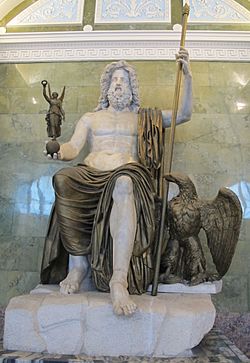Jupiter (mythology) facts for kids
Quick facts for kids Jupiter |
|
|---|---|
| God of the sky and lightning | |
| Member of the Archaic and Capitoline Triads | |

A marble statue of Jupiter from c. 100 AD
|
|
| Other names | Jove |
| Venerated in |
|
| Abode | Rome |
| Symbol | Lightning bolt, eagle, oak tree |
| Personal information | |
| Consort | Juno |
| Children | Mars, Vulcan, Bellona, Juventas |
| Parents | Saturn and Ops |
| Siblings | Roman tradition: Juno, Ceres, Vesta Greco-Roman: Pluto and Neptune |
| Greek equivalent | Zeus |
Jupiter (in Latin: Iuppiter) was the most important god in Roman mythology. He was known as the king of the gods. He was also the god of the sky and thunder. In Greek mythology, Jupiter is known as Zeus. His brother was Pluto, and his sister was Ceres.
Jupiter's main symbol is the thunderbolt. His special animal is the eagle. Often, artists showed Jupiter as an eagle holding a thunderbolt. You can see this on old Greek and Roman coins.
Contents
Jupiter's Name and Meaning

The Latin name Iuppiter comes from old words meaning "O Father Sky-god." It's like saying "Father Sky."
The old saying "by Jove!" comes from the Roman practice of swearing by Jupiter's name in courts. People used it to show they were telling the truth. The planet Jupiter is also named after this powerful god. The word "jovial," which means happy and cheerful, originally described people born under the planet Jupiter. Romans believed these people were naturally jolly.
Jupiter's name also gave us the word for Thursday. In Latin, Thursday was "Jove's day."
The Story of Jupiter
Jupiter's Birth
Before Jupiter, his father, Saturn, was the king of the gods. Saturn had been told that one of his children would take his place. Because of this, Saturn swallowed each of his children right after they were born. He swallowed Neptune, Pluto, Ceres, Juno, and Vesta.
When Jupiter's mother, Ops, was pregnant with him, she decided to save her baby. She secretly gave birth to Jupiter and moved to a place called Crete. To trick Saturn, she wrapped a stone in baby clothes and gave it to him to eat. Saturn thought he had swallowed Jupiter, but Jupiter was safe.
Overthrowing Saturn
Jupiter grew up hidden away. When he was older, he decided to get revenge on his father, Saturn, for what he had done to his brothers and sisters. Jupiter made Saturn throw up all the children he had swallowed.
Once all his siblings were free, Jupiter and his brothers and sisters joined forces. Together, they fought against Saturn and took away his power.
Battle Against the Titans
After defeating Saturn, Jupiter and his siblings, with help from powerful beings called Cyclopses and Hundred-handed Giants, declared war on the other Titans. The Titans were a group of powerful, ancient gods.
Jupiter finally won the battle against the Titans. He then imprisoned them in a dark, deep place called Tartarus.
Dividing the Universe
After their victory, Jupiter and his two brothers decided to divide the universe. They split it into three main parts:
- Jupiter received the heavens, becoming the ruler of the sky and the king of all gods.
- Neptune received the sea, becoming the god of the oceans.
- Pluto received the underworld, becoming the god of the dead.
This is how Jupiter became the most powerful god and the king of the gods.
Worshiping Jupiter
The most important temple for Jupiter was the Temple of Jupiter Optimus Maximus. It stood on the Capitoline Hill in Rome. People worshiped Jupiter there as a single, powerful god.
This temple was started by an early Roman king and finished by the last king. It was officially opened in 509 BC, at the start of the Roman Republic. On top of the temple, there were statues of four horses pulling a chariot, with Jupiter as the charioteer. Inside, there was a large statue of Jupiter. On special festival days, his face was painted red.
Jupiter's Role in the Roman State
The Romans believed that Jupiter represented the power and authority of Rome's leaders. He was important for how Rome was organized inside and how it dealt with other countries. Statues of Jupiter in the Capitol showed him with symbols of Rome's ancient kings and its highest leaders.
Roman leaders, called consuls, swore their promises in Jupiter's name. They honored him every year in September. To thank him and ask for his continued help, they would sacrifice a white ox with golden horns. Generals who won battles also honored Jupiter. They would place symbols of their victory at the feet of Jupiter's statue in the Capitol.
Related pages
- Tinia - Etruscan mythology equivalent to Jupiter
- Zeus - Greek mythology equivalent to Jupiter
- Odin - Norse mythology equivalent to Jupiter
Images for kids
-
Jupiter-Zeus with thunderbolt and sceptre in the clouds. Fresco in Herculaneum, 1-37 AD
-
Decor Fragment of a triumphal arch: The Emperor's Guards, The Praetorian Guard, featured in a relief with an eagle grasping a thunderbolt through its claws; in reference to Roman equivalent form of Jupiter.
-
Detail of relief from the Augustan Altar of Peace, showing flamines wearing the pointed apex
-
Jupiter in a wall painting from Pompeii, with eagle and globe, 62–79 AD
-
Emperor Marcus Aurelius, attended by his family, offers sacrifice outside the Temple of Jupiter Capitolinus after his victories in Germany (late 2nd century AD). Capitoline Museum, Rome
See also
 In Spanish: Júpiter (mitología) para niños
In Spanish: Júpiter (mitología) para niños











